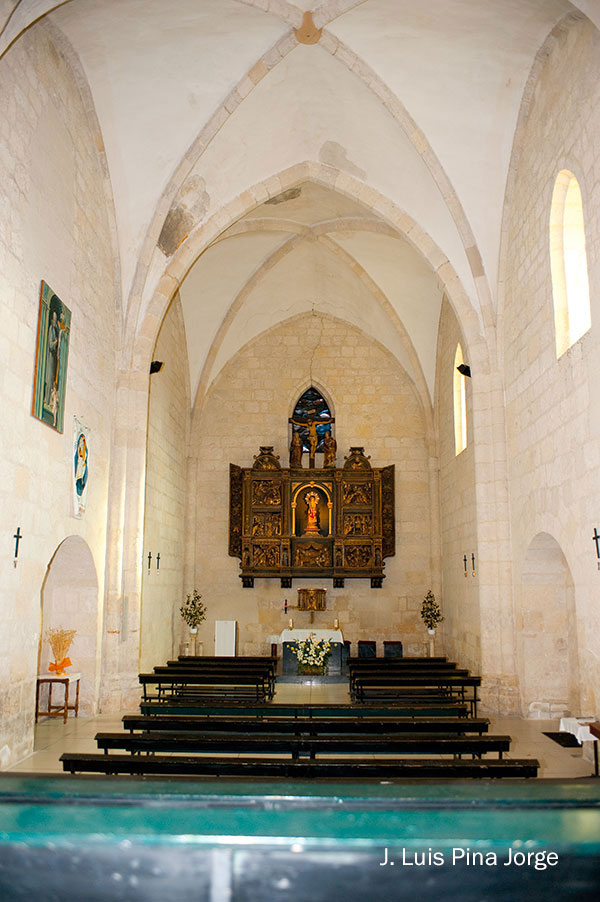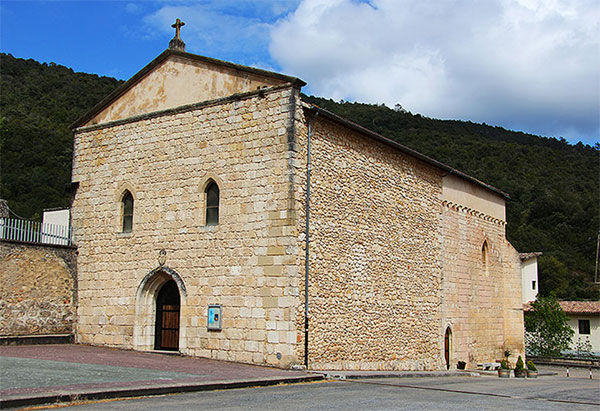The religious complex at Angosto consists of a series of modern buildings that accompany the parish church.
The area around Angosto is a fine natural park that is much visited, not only by people from the valley, but also those living much further afield.
The church is a beautiful, restored building that reveals its early Gothic construction.
In an attractive spot close to the river is Shepherd Hernando Martín’s cavern in which, according to tradition, a likeness of the Virgin was seen in 1089.

The popular legend whereby Hernando Martín, a shepherd from Villanañe, found a figure representing the Virgin dates back to 1089.
At first the figure was taken to San Pedro hermitage, which no longer exists.
Another hermitage was subsequently built, dedicated exclusively to worship of this figure. The new structure included a house for the hermit
When the shepherd died in 1167, the Angosto Virgin came under the influence
of Valpuesta.
The Valpositano chapter ordered part of the house to be devoted to lodging
pilgrims, and in time of war it would be a field dressing station.
Around the year 1300, Lord Rodrigo Varona, VII lord of the House of Villanañe, had a larger church built for the hermits and pilgrims, a task in which the whole Valley cooperated.
In 1880 the Passionists managed to become established in the sanctuary and, requesting co-operation from the inhabitants, built a convent which was finished in 1884.
During the night of the 9th/10th of March 1886, fire broke out which reduced the building to rubble, save for the church which remained intact.
The convent spent over two years in ruins while an attempt was made to seek a way of financing the building of a new one.
In 1890 the church received the first touches, a wooden floor being laid and the church extended.
The church and convent have since been extended and modified to meet the needs of the times.
THE LEGEND
The legend has it that one day in 1089 there was a heavy storm, thunder and lightning together with such heavy rainfall it caused the river Humecillo to burst its banks
Hernando Martín, a local shepherd, found himself in the vicinity with his flocks. He had to lead them to the pasture at the foot of the mountain on the other side of the river, so he waited for the waters to fall. As he approached the rocky crag of the Peñon del Calvario to see how he could cross, he made out from afar a vague shape “in the narrow (angosto) crevice of a rock” that he imagined to be a girl in clothing.
The shepherd ran to the village (Villanañe) to tell the inhabitants what had happened to him and what he had seen. Several of the villagers went with him to check the truth of his story, and when they saw in amazement that the figure was a likeness of the Virgin, they fell to their knees and saluted her with a Hail Mary.
They then returned to the village to tell the others their news, and the figure was moved to San Pedro hermitage.
There is evidence to show that the inhabitants of the region had already been Christians for a few hundred years, and it is reasonable to suppose that when the Arabs entered Spain and quickly made themselves its masters, the indigenous people hid their sacred figures until such time as they could drive the enemy from their lands.
For various reasons, in some cases these figures remained buried and even forgotten, perhaps until some event such as a storm uncovered them once again.

During some periods of history there is hardly any documentation mentioning the Sanctuary of Nuestra Señora de Angosto, but from the beginning it has always had a large popular following telling of miracles and healing and this has made it a spiritual objective for numerous pilgrimages.
Popular fairs (such as the cattle fair) and pilgrimages (romerías) from neighbouring villages continue to take place here, and the local nobility also used to meet here to come to agreements on justice and so on.
At the present time, the Mariano de Nuestra Señora de Angosto complex, less than a kilometre from the centre of Villanañe, is made up of:
Between this centre of religion and the village is the camp-site Camping de Angosto , with recreation areas, swimming pool, supermarket, restaurant, café-bar and so on.
